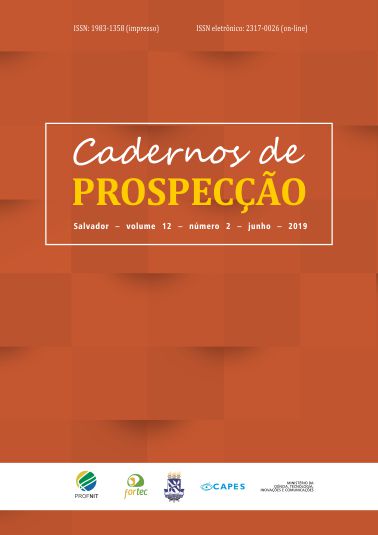Study and Technological Monitoring of the Effluent Treatment by Eletrocoagulation
DOI:
https://doi.org/10.9771/cp.v12i2.27286Keywords:
Electrocoagulation, Water treatment, Aluminum.Abstract
This paper addresses a study of the technological monitoring of electrocoagulation, using patents as sources of information. In order to collect information, the Questel Orbit® a private database was use applying the key words for the searches: "electrocoagulation", "water treatment" and "aluminum", in that was find and used fifty-six patent documents. Macro, meso and micro analyzes are carried out with the objective of analyzing the main technological characteristics related to the treatment of liquid effluents by electrocoagulation. The main application mentioned to electrocoagulation occurs in the area of removal of contaminants and inert electrodes with fifteen and sixteen patents respectively. Other important areas are those of electrocoagulation reactors with nine patents and that of precipitation with six documents. Among the technologies related to electrocoagulation, the ones that stood out most were wastewater treatment and modification of the anode and/or cathode, accounting for 51.43% of the total of the analyzed documents.
Downloads
References
ABDERRAZAK, B; ABDERRAHMANE, D. Apparatus and method for wastewater treatment by means of electroflotation and/or electrocoagulation. Technologies Elcotech, [S.l.], 23 jul. 2012; 9 jan. 2018. n. WO 20045056 – 2.
ANGELIS, D. F. et al. Eletrólise de resíduos poluidores. I – Efluente de uma indústria iofilizadora de condimentos. Revista Química Nova, Santa Catarina, n. 1, v. 21, p. 20–24. 1998.
BANSAL, S.; KUSHWAHA, J. P.; SANGAL, V. K. Electrochemical treatment of reactive black 5 -textile wastewater: optimization, kinetics, and disposal study. Water Environ, [S.l.], v. 85, p. 2294–2306, 2013.
CHOU, W. L. et al. Electrochemical removal of salicylic acid from aqueous solutions using aluminum electrodes, Desalination, [S.l.], v. 271, p. 55–61, 2011.
FERNANDES, T. F et al. Planta experimental para tratamento de efluente da produção do biodiesel. In: CONGRESSO TÉCNICO CIENTÍFICO DA ENGENHARIA E DA AGRONOMIA. 15 a 18 set. 2015, Fortaleza. Anais... Disponível em: <http://www.confea.org.br/media/Quimica_planta_experimental_para_tratamento_de_efluente_da.pdf
GOBBI, L. R. A. Tratamento de água oleosa por eletrofloculação. Espirito Santo: CUNES, 2013. Originalmente apresentada como dissertação de mestrado, Universidade Federal do Espírito Santo.
MENESES, J. M. et al. Treatment of biodiesel wastewater by electrocoagulation/flotation process: investigation of operational parameters. Revista Química Nova, Santa Catarina, v. 35, n. 2, p. 235–240, 2012.
PALAHOUANEA, B. et al. Cost-effective electrocoagulation process for the remediation of fluoride from pretreated photovoltaic wastewater. Journal of Industrial and Engineering Chemistry, [S.l.], v. 22, p. 127–131, 2015.
QUESTEL ORBIT. Orbit Intelligence. Disponível em: <https://www32.orbit.com/>. Acesso em: jun. 2018.
WU PI, K. et al. Decolorization of synthetic Methyl Orange wastewater by electrocoagulation with periodic reversal of electrodes and optimization by RSM. Process Safety and Environmental Protection, [S.l.], v. 92, n. 6, p. 796–806. 2014.
YEHIA, A. EL-T.; EHSSAN, M. N; IMAN, E. D. S. Removal of Cr (VI) ions from wastewater by electrocoagulation using iron electrode. Egyptian Journal of Petroleum, [S.l.], v. 24, p. 183–192. 2015.
YOUSIF, H. R. Electrolytic process for removing fluorides and other contaminants from water. 23 nov. 2006, 3 mar. 2010. n. EP 2158163.
ZHU, H. et al. Polyacrylamide grafted cellulose as an eco-friendly flocculant: Key factors optimization of flocculation to surfactant effluent, Carbohydrate Polymers, [S.l.], v. 135, p. 145–152. 2016.
ZHU, J. et al. Removal of antimony from antimony mine flotation wastewater by electrocoagulation with aluminum electrodes. Journal of Environmental Sciences, [S.l.], v. 23, n.7, p. 1066–1071. 2011.
Downloads
Published
How to Cite
Issue
Section
License
Copyright (c) 2019 Cadernos de Prospecção

This work is licensed under a Creative Commons Attribution-NonCommercial 4.0 International License.
O autor declara que: - Todos os autores foram nomeados. - Está submetendo o manuscrito com o consentimento dos outros autores. - Caso o trabalho submetido tiver sido contratado por algum empregador, tem o consentimento do referido empregador. - Os autores estão cientes de que é condição de publicação que os manuscritos submetidos a esta revista não tenham sido publicados anteriormente e não sejam submetidos ou publicados simultaneamente em outro periódico sem prévia autorização do Conselho Editorial. - Os autores concordam que o seu artigo ou parte dele possa ser distribuído e/ou reproduzido por qualquer forma, incluindo traduções, desde que sejam citados de modo completo esta revista e os autores do manuscrito. - Revista Cadernos de Prospecção está licenciado com uma Licença Creative Commons Attribution 4.0. Esta licença permite que outros remixem, adaptem e criem a partir do seu trabalho para fins não comerciais, e embora os novos trabalhos tenham de lhe atribuir o devido crédito e não possam ser usados para fins comerciais, os usuários não têm de licenciar esses trabalhos derivados sob os mesmos termos.
Este obra está licenciado com uma Licença Creative Commons Atribuição 4.0 Internacional.





